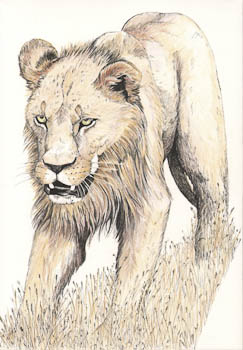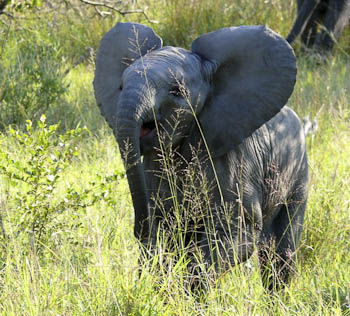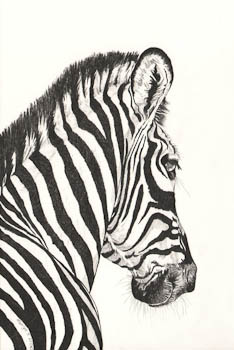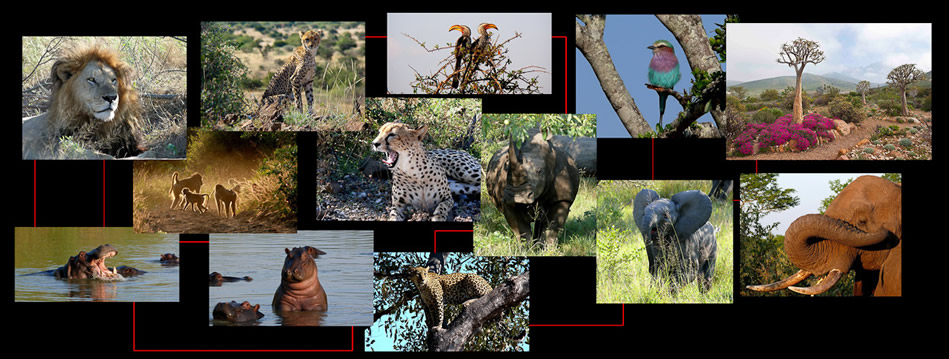A NATURALIST'S JOURNEY:
FROM SOUTH AFRICA'S FAIREST CAPE TO THE JEWEL OF NAMIBIA
September 1-19, 2012 19 days/18 nights 
Patrick Cardwell and Local Guides
 The landscapes of southern Africa provide a compelling and dramatic backdrop to its magnificent wildlife. Our journey begins in Cape Town, at the southwestern tip of the African continent, with the magic of a visit to the Cape of Good Hope Nature Preserve. We'll be introduced to the amazing flora of South Africa here and at the world-renowned Kirstenbosch Botanical Gardens. We should also see a few of South Africa's emblematic wildlife species—antelope such as the eland, bontebok (the rarest and most distinctively marked), grey rhebok, and red hartebeest. At Simon's Town, on Boulders Beach, we'll observe and photograph a colony of African penguins and enjoy the beauty of a sunset over False Bay. The landscapes of southern Africa provide a compelling and dramatic backdrop to its magnificent wildlife. Our journey begins in Cape Town, at the southwestern tip of the African continent, with the magic of a visit to the Cape of Good Hope Nature Preserve. We'll be introduced to the amazing flora of South Africa here and at the world-renowned Kirstenbosch Botanical Gardens. We should also see a few of South Africa's emblematic wildlife species—antelope such as the eland, bontebok (the rarest and most distinctively marked), grey rhebok, and red hartebeest. At Simon's Town, on Boulders Beach, we'll observe and photograph a colony of African penguins and enjoy the beauty of a sunset over False Bay.
There is something in the sun-baked and seemingly barren landscape of Namibia that makes this country irresistible to naturalists. Most of us imagine African savannas as lush grasslands stretching beyond the horizon. Namibia is utterly different—beautiful and surreal in equal measure. Its extraordinary wildlife, which seem uniquely adapted to this harsh environment, often appear like a mirage amidst the swirling, shimmering heat waves. In deserts, like anywhere else, the struggle for survival revolves around finding food and successfully rearing young. Temperature extremes and water scarcity only add to the challenge. Though insects and reptiles have the adaptive edge in coping with their environment, Namibia's birds and mammals have learned to exploit their opportunities, albeit brief, when the desert offers favorable conditions. Geologists believe that the Namib Desert, having formed some 80 million years ago, is the world's oldest desert. The unique adaptations of its plants and animals clearly mirror this ancient evolutionary tapestry. Our Namibian explorations highlight three regions showcasing the country's beauty and wildlife diversity—the Sossusvlei Section of Namib-Naukluft Park, the coastal wilderness north of Swakopmund, and Etosha National Park.
 We fly in a covey of small planes from Windhoek, Namibia's capital city, to a landing strip near the towering orange dunes of Sossusvlei. NamibNaukluft Park, the largest nature reserve in Africa, is divided into four distinct areas. Our stay within the Sossusvlei Section of the park, provides us with magnificent views of the dunes, unparalleled hiking, and the opportunity to experience and photograph the fire-orange of a dune sunset. Geologists believe these vast dune fields, which continue migrating north and west in a constant cycle with the prevailing winds, as well as the Namib Desert's extreme aridity, are linked to the development of the Atlantic Ocean's cold Benguela Current at least 5 million years ago. We fly in a covey of small planes from Windhoek, Namibia's capital city, to a landing strip near the towering orange dunes of Sossusvlei. NamibNaukluft Park, the largest nature reserve in Africa, is divided into four distinct areas. Our stay within the Sossusvlei Section of the park, provides us with magnificent views of the dunes, unparalleled hiking, and the opportunity to experience and photograph the fire-orange of a dune sunset. Geologists believe these vast dune fields, which continue migrating north and west in a constant cycle with the prevailing winds, as well as the Namib Desert's extreme aridity, are linked to the development of the Atlantic Ocean's cold Benguela Current at least 5 million years ago.
Namibia's coast provides a striking series of contrasts between the vast dune fields and the wild South Atlantic Ocean. Driving towards Swakopmund, we pass along the western edge of the Khomas Hochland Mountains, which rise to 2000 meters above sea level, before turning west across the Namib Desert to the seabird-rich waters of Walvis Bay. In addition to both the whitefronted and the chestnut plover, we should also see large numbers of lesser and greater flamingos. Making our way across the gravel plains and sandy river beds, we'll watch for Ruppell's korhaan, Namaqua sandgrouse and double-banded courser. We'll also be on the lookout for bat-eared fox, black-backed jackal, and aardwolf amidst the termite mounds that dot the plain. Traveling in customized 4x4 vehicles along the Swakop River, we explore a moonscape populated by "stilting" ground beetles, shovel-snouted lizards, skinks, chameleons, sidewinders, blind worms, scorpions, and golden moles. Among the many unusual plants adapted to these extreme conditions—the living rocks (Lithops), fetid-smelling hoodias, and fog-gathering lichens—we'll search for the world's most bizarre species, the Namibian endemic Welwitschia mirabilis. Arriving at the river's mouth, on the rocky outer coast, we'll see greater flamingos, African black oystercatchers, Cape and white-breasted cormorants, great white pelicans, and many other species. Continuing north, towards the Skeleton Coast wilderness, we visit the Cape Cross Fur Seal Reserve, home to a colony of Cape fur seals, the largest fur seal species in the world.
Shifting our attention inland to southern Damaraland and the Brandberg Mountains, Namibia's highest mountain range, we settle into the White Lady Lodge, named for an internationally famous San (Bushman) rock painting. We'll have two days to explore the dry tree-lined corridor of the Ugab River, a preferred travel route for the desert adapted Namib elephant. Birdwatching should be excellent and we can expect regional specialties such as pearl-spotted owl, violet woodhoopoo, crimson-breasted shrike, swallow-tailed bee-eater, and many others.
 Etosha is one of Africa's great national parks and the wildlife viewing here is on par with South Africa's Kruger, Kenya's Masai Mara, or Tanzania's Serengeti. Our approach to the park is along the route taken by Swedish explorer Charles Andersson in the mid-19th century. The forest vegetation becomes increasingly lush as we get closer, with acacia thornveld giving way to broadleaf woodland and open savannah. In the local Ovambo dialect, Etosha means "the place of dry water," in reference to the vast white salt pan that covers at least a third of this enormous park. Etosha is world-famous for the abundance and diversity of animals attracted to the waterholes dotting the edges of the salt pan. Our multi-day visit is timed to coincide with the dry season, when herds of elephants, giraffes, zebras, kudus, springbok, oryx, gemsbok, and many other animal species are concentrated around the principal waterholes. To experience Etosha's wildlife diversity, we'll stay at three unique safari camps—Namutoni, Halali, and Okaukuejo—each with spring-fed waterholes attracting predator and prey alike. Etosha is well-known for its predator populations and patient observers are often rewarded with good sightings of hyenas, a pride of lions, a family of cheetahs, or a solitary leopard. Our Namibian journey concludes at Waterberg Plateau National Park, a splendid flattopped mountain flanked by sheer sandstone cliffs. We'll hope to see both white and black rhinos here, as well as roan antelope, sable, rock hyrax, and the banded mongoose. Join us for a magical Namibian desert odyssey! Etosha is one of Africa's great national parks and the wildlife viewing here is on par with South Africa's Kruger, Kenya's Masai Mara, or Tanzania's Serengeti. Our approach to the park is along the route taken by Swedish explorer Charles Andersson in the mid-19th century. The forest vegetation becomes increasingly lush as we get closer, with acacia thornveld giving way to broadleaf woodland and open savannah. In the local Ovambo dialect, Etosha means "the place of dry water," in reference to the vast white salt pan that covers at least a third of this enormous park. Etosha is world-famous for the abundance and diversity of animals attracted to the waterholes dotting the edges of the salt pan. Our multi-day visit is timed to coincide with the dry season, when herds of elephants, giraffes, zebras, kudus, springbok, oryx, gemsbok, and many other animal species are concentrated around the principal waterholes. To experience Etosha's wildlife diversity, we'll stay at three unique safari camps—Namutoni, Halali, and Okaukuejo—each with spring-fed waterholes attracting predator and prey alike. Etosha is well-known for its predator populations and patient observers are often rewarded with good sightings of hyenas, a pride of lions, a family of cheetahs, or a solitary leopard. Our Namibian journey concludes at Waterberg Plateau National Park, a splendid flattopped mountain flanked by sheer sandstone cliffs. We'll hope to see both white and black rhinos here, as well as roan antelope, sable, rock hyrax, and the banded mongoose. Join us for a magical Namibian desert odyssey!
 Price: $8,500 (includes a $2,000 deposit) Price: $8,500 (includes a $2,000 deposit)
Group Size: 14
Trip Rating: 2-3
Price Includes: pre-departure expedition packet, expert naturalist guide services, all domestic air and vehicle transportation while in South Africa and Namibia, all lodging, all meals, all airport and hotel transfers, all park entrance fees and permits, and all gratuities. Does not include roundtrip air transportation to Cape Town, South Africa from your home airport or other point of departure.
Special Note:  indicates a two-day time allowance for international/overnight flights. indicates a two-day time allowance for international/overnight flights.
Photographs on the South Africa and Namibia pages courtesy of Carlos Passera |
